|
 |
|
 |
|
Mary of Magdala, who was the first to
witness Jesus' resurrection, was cast in a
provocative, very unbiblical role in author
Dan Brown’s best-selling fantasy, “The Da
Vinci Code.” In the aftermath of the
success of the 2003 novel, Magdala, Mary’s
hometown a few miles north of Tiberias on
the western shore of the Sea of Galilee,
attracted a surge of curiosity seekers and
cult followers. |
|
|
|
 |
|
Photo:
Gila Yudkin |
|
Magdala as seen from Mount
Arbel lies at the bottom right corner |
|
|
|
But they missed it! No one really knew the
location of Mary's authentic hometown until
2009 when a salvage dig conducted by the
Israeli Antiquities Department struck pay
dirt, so to speak. Less than one foot
under the topsoil, a first century AD
synagogue was discovered, including a
decorated stone block that archeologists say
was probably used as a table for reading the
Torah. The stone may even be a
miniature of the Jerusalem Temple with its
ornate columns and arches, a seven-branched
menorah flanked by vessels for wine and oil,
a 12-leaf rosette and chariots of fire. |
|
|
|
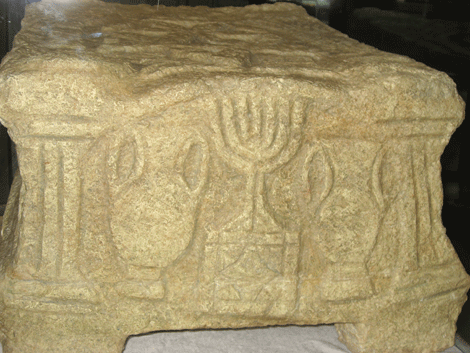 |
|
Photo:
Gila Yudkin |
|
Menorah relief found in
the middle of Magdala's synagogue of Jesus' day |
|
|
|
A local coin found in a side room in the
synagogue was dated to the year 29. Matthew
says, "Jesus went all through Galilee,
teaching in its synagogues, preaching the
good news of the Kingdom of God and curing
the sicknesses and the ailments of the
people." Wow – did Jesus preach in this VERY
synagogue? |
|
|
|
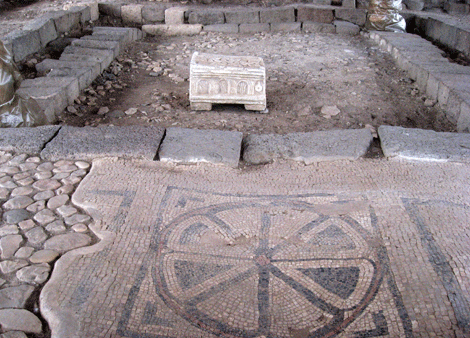 |
|
Photo:
Gila Yudkin |
|
Mosaic found in first
century AD Magdala synagogue |
|
|
|
We know that Magdala, on the shores of the
Sea of Galilee, was a Galilean hub for the
fish industry. Indeed, one of its most
populous quarters was called Tarichae in
Greek, meaning the place of the fish-salters.
From here fish were exported to Judea and
around the Mediterranean world. (I'll bet
even Augustus Caesar delighted in serving
pickled Magdala fish as tasty appetizers at
his extravagant banquets.)
|
|
|
|
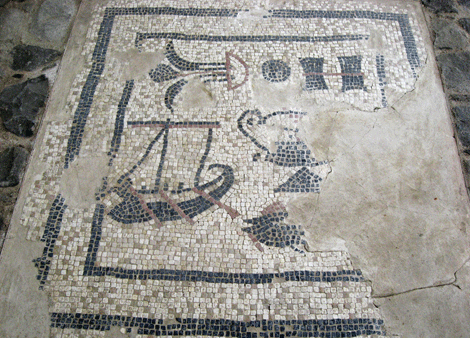 |
|
Photo:
Gila Yudkin |
|
Magdala mosaic showing
first century AD fishing boat |
|
|
|
Archeologists have uncovered an ancient
marketplace with a separate area of rooms
for water pools presumably to produce salted
cured fish, along with a fisherman's
neighborhood and a section of a
first-century inner harbor. First century AD
historian Josephus mentions 230 (!) boats
out in the sea, opposite Magdala during the
Jewish revolt against the Romans. (And let's
not forget that the ancient boat -- dubbed
"the Jesus boat" -- was discovered in 1986
by two fishermen, right on this very shore.) |
|
|
|
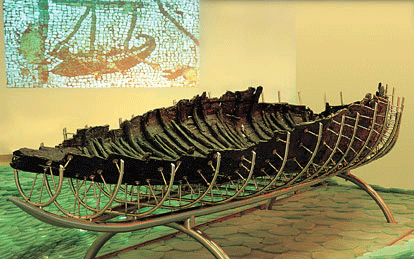 |
|
Courtesy of
Jesus Boat Shop |
|
First century AD fishing boat
found by the shores of Magdala in 1986 |
|
|
|
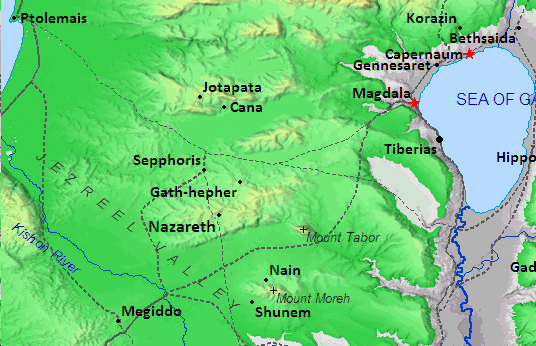 |
|
Adapted
from Bible Mapper by itsGila |
|
Map of Galilee showing
prominent towns in Jesus' day |
|
|
|
Mary Magdalene, then, came from a very
prosperous thriving town with a synagogue.
Uniquely, among the gospels, she is
specified by name as a witness to three key
events: Jesus' crucifixion, his burial and
the discovery that his tomb was empty. Both
John and Mark specifically name her as the
first person to see Jesus after his
resurrection. |
|
|
|
However, in the Middle Ages, Mary's
reputation plummeted. She metamorphosed into
the unnamed sinner in Luke 7 who anointed
Jesus' feet with her tears. Mary
Magdalene as "repentant prostitute" became
the most commonly depicted woman in Western
Medieval Christian art after the Virgin
Mary.
|
|
|
|
She is often shown as either provocatively
dressed or stark naked, covered by her long
flowing blond or reddish blond tresses.
The artists – and the church -- ignored the
gospel references and had forgotten that the
preeminent early church theologian Augustine
had identified her as the "apostle to the
apostles." |
|
|
|
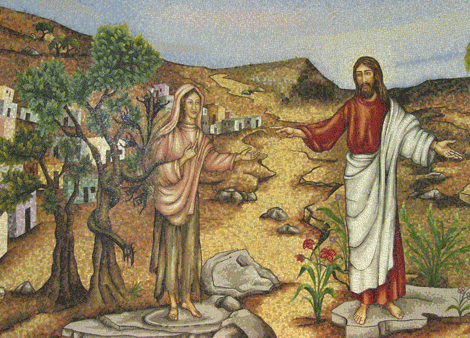 |
|
Mosaic in
Duc in Altum Chapel at Magdala |
|
Jesus meeting Mary
Magdalene | the town of Magdala is at left |
|
|
|
But now we have an authentic place to
contemplate the real Mary Magdalene and her
role in Jesus' public ministry. The site of
Magdala itself (so far) is understated.
The excavations are visible and there's a
lot to see. For those of a spiritual
bent, there is an ecumenical center with
breathtaking mosaics recalling pivotal
events in this area – the call of the
fishermen, the casting out of demons and
Talitha cumi. |
|
|
|
The chapel itself is named "Duc in Altum"
which means in Latin, "put out into the
deep" from Luke 5:4. (He said to Simon,
'Launch out into the deep and let down your
nets for a catch')
|
|
|
|
 |
|
Mosaic in
Duc in Altum Chapel at Magdala |
|
"Lord save me!" mosaic in
Magdala Chapel |
|
|
|
Come with me to Magdala
and we will go "into the depths" to explore
together Jesus' ministry and message in
Galilee! Gila | March 2015 |
|
|
|
Copyright 2015 Gila Yudkin. Permission
needed for any reuse. |
|
|
|
Postscript March 2022 |
|
|
|
During my first stay at Magdala’s glorious
pilgrims guest house, in March 2022, I
discovered something amazing. Access
to the ruins of ancient Magdala including
its first century AD synagogue is
unrestricted (and free) 24/7 from the hotel.
I took advantage of the opportunity and
offered my group an early bird
pre-breakfast optional tour and walk-around
the site at 6.45 a.m. And I am
happy to report that the majority of the
group joined me!
|
|
|
|
Needless to say, at that hour, we were the
only ones touring ancient Magdala, one of
the most popular sites in Galilee. As
we exited the guest house, we were almost
immediately inside the ancient synagogue,
demonstrating that the guest house was to
have been built (unknowingly) over the first
century AD synagogue. Thank goodness
for the bylaw ordering an exploratory
salvage dig before construction!
|
|
|
|
One pilgrim asked how the synagogue is dated
to 29 AD. After all, there was no AD yet!
The coin found on the floor of a side room
of the synagogue is inscribed on one side
with the Greek letters ΗΡWΔΟΥ ΤЄΤΡΑΡΧΟΥ
(Herod the Tetrarch, i.e., Herod Antipas,
son of Herod the Great) around a palm branch
with the year 33 ΛΓ, the number of years he
had been ruling since his father's death in
4 BC. |
|
|
|
 |
|
Both sides of the coin
found in a side room which dates the
synagogue to 29 AD |
|
|
|
The reverse side of the coin inscription
says ΤΙΒЄΡΙΑC. Tiberius, the step-son
of Augustus, was the emperor at that time.
His name is surrounded by a laurel wreath.
|
|
|
|
Since the excavations began in 2009, over
4,000 coins, 28 shops, 300 fishing weights
and 40 fish ponds have been found.
And no less than five mikvehs, Jewish
ritual baths (see Leviticus 15). Today
there is no doubt that the prosperous
Magdala was not only at the geographical
crossroads, located at a vital
intersection of the Via Maris, the
international trade route. But also,
Magdala held a key position at the
cultural crossroads of Judaism’s
adaptation to Greek and Roman culture.
|
|
|
|
And Magdala has continued to surprise even
the most seasoned archeologists. The
Magdala excavation team announced in
December 2021 that a second synagogue
dating to the Second Temple period has
been found!
|
|
|
|
It is the first time two synagogues from the
first century AD have been found in a single
town. The newly unearthed one is smaller and
apparently not as ornate as the first, which
was found in 2009, but together they shed
new light on the observance of Judaism in
this cosmopolitan wealthy town. |
The first synagogue featured brightly
colored frescoes on the walls. The second
one had white-plastered walls, though some
evidence of wall paintings has survived.
Both had the same basic plan: a square
central meeting hall and two rooms on the
side. In both cases, the side room in the
southwestern corner had a plastered stone
shelf which, the archaeologists speculate,
may have served to store the Torah scrolls. |
|
|
|
 |
|
Photo by
Lisa Olson on tour with Gila in 2022 |
|
Colored fresco on basalt
stone entrance to first Magdala synagogue
discovered |
|
|
|
The second synagogue is still being
excavated and studied. Stay tuned
for further developments at Magdala, Mary
Magdalene's home town! |
|
|
|
Copyright March 2022 Gila Yudkin. Permission
needed for any reuse. |
|
|
|
When American humorist Mark Twain visited
the Holy Land, Magdala was on his itinerary. Tongue in cheek he vividly described being
greeted by its blind, crazy, and crippled
residents, all begging for baksheesh. |
|
|
|
Then he wrote that he and his entourage
“filed through the town with many exquisite
frescoes till we came to a bramble-infested
enclosure and a Roman-looking ruin which had
been the veritable dwelling of St. Mary
Magdalene, the friend and follower of Jesus. The guide believed it, and so did I. I could
not well do otherwise, with the house right
there before my eyes as plain as day. The
pilgrims took down portions of the front
wall for specimens, as is their honored
custom, and then we departed.” |
|
|
|
Perhaps that’s why Magdala’s ruins are so
sparse today! If you are a Mark Twain fan,
or contemplating a holy land tour, see
Mark Twain's Tips for Holy Land Pilgrims for travel
tips relevant for contemporary holy land
pilgrims. |
|
|
|
Earlier, in 1838,
Edward Robinson, the Connecticut
Yankee considered the
father of biblical
geography, visited Magdala while
searching for the ruins of Capernaum, the
headquarters of Jesus’ Galilean ministry.
|
|
|
|
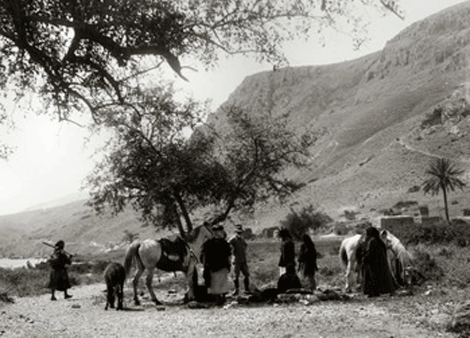 |
|
Courtesy of
Northmat |
|
Photo of Magdala in the
late 19th century |
|
|
|
Mary Magdalene is said to be tied to the
tradition of painted eggs at Easter.
It's said that following the death and
resurrection of Jesus, Mary used her
position to gain an invitation to a banquet
hosted by the Emperor Tiberias. When
she met him, she held an egg in her hand and
exclaimed, "Christ has risen!" The
Emperor laughed and said that Christ rising
from the dead was as likely as the egg in
her hand turning red while she held it.
Just then, as he finished speaking, the egg
in her hand turned a bright red. |
|
|
|
For more Mary Magdalene stories,
book
Gila to visit the 24-carat gold
onion-domed Church of Mary Magdalene on the
slopes of the Mount of Olives. And to
hear about the
astounding and improbable
life of Princess Alice,
mother-in-law of Queen Elizabeth II and
great-granddaughter of Queen Victoria who is
buried in the Church of Mary Magdalene in
Jerusalem. |
|
|

